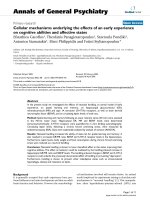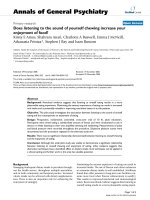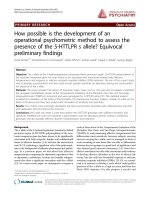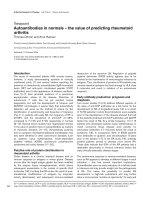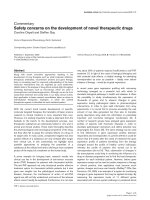Báo cáo y học: "Autoantibodies in normals – the value of predicting rheumatoid arthrits" doc
Bạn đang xem bản rút gọn của tài liệu. Xem và tải ngay bản đầy đủ của tài liệu tại đây (180.18 KB, 3 trang )
282
CI = confidence interval; CCP = cyclic citrullinated peptide; HLA = human leukocyte antigen; IDDM = insulin dependent diabeties mellitus; MHC =
major histocompatibility complex; PADI = peptidyl arginine deiminase; OR = odds ratio; RA = rheumatoid arthritis; RF = rheumatoid factor.
Arthritis Research & Therapy Vol 6 No 6 Dörner and Hansen
Introduction
The cause of rheumatoid arthritis (RA) remains elusive,
however, a study demonstrating synovitis in clinically
uninflamed joints [1] and several studies reporting the
presence of characteristic autoantibodies (IgM rheumatoid
factor [RF] and anti-cyclic citrullinated peptide [CCP]
antibodies) prior to the appearance of disease manifesta-
tions [2–7] have provided evidence of a preclinical,
asymptomatic, phase of the disease. Detection of
autoimmune T cells has not yet reached routine
diagnostics, but with the development of tetramer and
ELISPOT technologies it seems likely that autoantibody
detection will serve as the method of choice for the
identification of autoimmunity and breaches of tolerance
(Fig. 1). In patients with early RA, the frequency of RF is
50-66% and the prevalence of anti-CCP 41–48%,
compared to 7–13% and 3–9% respectively in normals
[8–10]. Several recent studies have regenerated interest
in the value of positive titres of autoantibodies as markers
of rheumatic diseases [11–15]. Autoantibody positivity
prior to symptom development/disease manifestation has
also been identified in other autoimmune diseases, such
as systemic lupus erythematosus, insulin-dependent
diabetes mellitus (IDDM), autoimmune polyendocrine
syndromes and celiac disease [11–20].
Putative role of protein citrullination in
rheumatoid arthritis
Celiac disease is a chronic intestinal disease with an
immune response to antigens in wheat gluten. Disease
occurs after the target antigen gliadin has been modified
by the enzyme tissue transglutaminase, which allows
subsequent presentation in the context of specific HLA
molecules [19]. It is likely that RA is also the result of post-
translational modifications of antigens by enzymatic
activity (deiminases), and subsequent immune-mediated
destruction of the synovium [9]. Regulation of peptidyl
arginine deiminase (PADI) activity appears also to be
involved in the maintenance of immunological tolerance to
antigens. Thus, citrullination of proteins in RA patients may
unmask essential epitopes that bind strongly to HLA class
II molecules and result in initiation of an autoimmune
response.
Early antibody production: prognosis and
diagnosis
Two recent studies [14,15] address different aspects of
the value of anti-CCP antibodies as a risk factor for the
development of RA. A longitudinal study [14] in a cohort
of 79 RA patients in whom blood donations were available
prior to the development of the disease showed that half
of the patients produced anti-CCP antibodies and IgM-RF
before the onset of RA. At a similar frequency, 10 of 16
patients who developed systemic lupus erythematosus or
mixed connective tissue disease were positive for
antinuclear antibodies 0.7–4.5 years before the onset of
symptoms [16]. In comparison, 82% of IDDM patients
have antibodies to glutamic acid decarboxylase 10 years
prior to the disease [17]. In the RA study [14], antibody
positive patients proved to develop more severe RA.
These data indicate that 50% of the RA patients had a
detectable abnormality in immune tolerance before the
early clinically detectable disease stages.
The autoimmune response in immune-mediated diseases,
such as RA appears to develop at different stages in each
individual – this has several important implications.
Autoantibodies serve as early indicators of a definite break
in tolerance and may provide insight into the pathogenesis
of RA. This raises the possibility to predict RA
development in high-risk populations and may further
allow a more precise “window of opportunity” for early and
Viewpoint
Autoantibodies in normals – the value of predicting rheumatoid
arthritis
Thomas Dörner and Arne Hansen
Charite University Medicine Berlin, Free University and Humboldt University Berlin, Berlin, Germany
Corresponding author: Thomas Dörner,
Published: 15 October 2004
Arthritis Res Ther 2004, 6:282-284 (DOI 10.1186/ar1456)
© 2004 BioMed Central Ltd
283
Available online />effective treatment interventions. Moreover, modulation of
the immune response to a given antigen might alter the
future disease course. A further important recent lesson
learned is that serologic prediction of the disease can be
greatly improved by considering the presence of
combinations of autoantibodies [20]. Although a clear
pathogenic link between RF and anti-CCP antibody is
missing, their co-presence is highly indicative of RA [21].
Likely antibody combinations reflect a spreading of the
immune response to include more than one antigenic
determinant with an associated increase in the risk of
progression to disease [21]. Spreading of this immune
response is probably genetically determined [22].
The value of positive autoantibodies in RA can only be
considered midst a complex pattern of additional
predictive markers. Another recent prospective study [15]
evaluated patients with undifferentiated early arthritis. Of
the 936 patients, 21.9% had RA at inclusion, 32% after
1 year, 38% after 2 years and 40% after 3 years of follow-
up. Importantly, the presence of anti-CCP antibodies was
identified as a significant risk factor for RA with an odds
ratio (OR) of 37.8 (95% confidence interval [CI]
13.8–111.9) while IgM-RF had an OR of 9.8 (95% CI
4.1–23.4). Major predictive clinical variables were morning
stiffness, polyarthritis, symmetric arthritis and erosions on
radiographs. Although serologic abnormalities had a high
OR, these data emphasize the importance of a clinical
pattern that needs to be identified for preclinical
conditions with antibody positivity.
Associated genetic markers
Genetic factors, for example HLA-DR haplotypes and
PADI gene polymorphisms, represent further intriguing
candidates for prediction. Hill et al., identified the specific
role of MHC class II molecules in presenting citrullinated
peptides to the immune system by studying T-cell
responses to citrulline-containing peptides in HLA-
DRB1*0401 transgenic (DR4-IE tg) mice [22]. They
demonstrated that the conversion of arginine to citrulline
at the peptide side-chain position interacting with the
shared epitope significantly increased peptide-MHC
affinity and led to the activation of CD4
+
T cells. These
data could, therefore, explain how DRB1 alleles with the
shared epitope initiate an autoimmune response to
citrullinated peptides in RA patients. Further studies
[23,24] focussed on an involvement of peptidylarginine
deiminases citrullinating enzymes (encoded by PADI
genes). In a Japanese case-control linkage disequilibrium
study [23], PADI type 4 was identified as a susceptibility
locus for RA; this was not found in a UK population of RA
patients [24] indicating the need for further studies. The
role of genetics in RA is further supported by the
observation that an anti-CCP+ member of a multicase RA
family has an estimated 69.4% risk of developing RA
within 5 years [15].
Open questions/conclusions
A number of questions have been raised by these studies:
(1) Since only 50% of RA patients develop autoantibodies
before the onset of disease, the question remains whether
other unknown humoral disturbances might be present in
the remaining patients or if there are different subgroups
of patients independent of the presence of RF and/or anti-
CCP antibodies before disease develops; (2) The
American College of Rheumatology criteria [25] for RA are
commonly used for classification based on patient’s
history, physical examination, laboratory and radiographic
findings. Early diagnosis of RA in patients with arthritis of
recent onset [26,27] is often difficult. New aspects of the
prognostic value of autoantibodies lead us to question
whether our current diagnostic standard in RA needs re-
evaluation; (3) Although we have progressed remarkably
in our therapeutic armamentarium as well as in identifying
high-risk subjects for RA through antigen-specific
autoantibodies, screening the appropriate population for
RA susceptibility remains a challenging task.
Identification of an autoimmune response to specific
autoantigens in the pre-RA period raises the prospect of
prediction and prevention. This may allow early treatment
interventions (secondary prevention) and potentially
disease prevention (primary prevention). However,
accurate disease prediction is vital for secondary
prevention in the context of clinical manifestations. At last,
this will require not only a reliable view through the
“window of opportunity” but also a subsequent successful
step through a “gate of new opportunities”.
Competing interests
The author(s) declare that they have no competing interests.
Figure 1
Proposed model of the development of autoimmunity influenced by
genetic and environmental factors at certain stages.
284
Arthritis Research & Therapy Vol 6 No 6 Dörner and Hansen
References
1. Kraan MC, Versendaal H, Jonker M, Bresnihan B, Post WJ, t Hart
BA, Breedveld FC, Tak PP: Asymptomatic synovitis precedes
clinically manifest arthritis. Arthritis Rheum 1998; 41:1481-
1488.
2. Silman AJ, Hennessy E, Ollier B: Incidence of rheumatoid
arthritis in a genetically predisposed population. Br J Rheuma-
tol 1992, 31:365-368.
3. Aho K, Heliovaara M, Maatela J, Tuomi T, Palosuo T: Rheumatoid
factors antedating clinical rheumatoid arthritis. J Rheumatol
1991, 18:1282-1284.
4. Kurki P, Aho K, Palosuo T, Heliövaara M: Immunopathology of
rheumatoid arthritis: antikeratin antibodies precede the clini-
cal disease. Arthritis Rheum 1992, 35:914-917.
5. Halldorsdottir HD, Jonsson T, Thorsteinsson J, Valdimarsson H: A
prospective study on the incidence of rheumatoid arthritis
among people with persistent increase of rheumatoid factor.
Ann Rheum Dis 2000, 59:149-151.
6. Del Puente A, Knowler WC, Pettitt DJ, Bennett PH: The inci-
dence of rheumatoid arthritis is predicted by rheumatoid
factor titer in a longitudinal population study. Arthritis Rheum
1988, 31:1239-1244.
7. Walker DJ, Pound JD, Griffiths ID, Powell RJ: Rheumatoid factor
tests in the diagnosis and prediction of rheumatoid arthritis.
Ann Rheum Dis 1986, 45:684-690.
8. Goldbach-Mansky R, Lee J, McCoy A, Hoxworth J, Yarboro C,
Smolen JS, Steiner G, Rosen A, Zhang C, Menard HA, Zhou ZJ,
Palosuo T, Van Venrooij WJ, Wilder RL, Klippel JH, Schumacher
HR Jr, El-Gabalawy HS: Rheumatoid arthritis associated
autoantibodies in patients with synovitis of recent onset.
Arthritis Res 2000, 2:236-243.
9. Schellekens GA, Visser H, de Jong BAW, van den Hoogen FHJ,
Hazes JMW, Breedveld FC, van Venrooij WJ: The diagnostic
properties of rheumatoid arthritis antibodies recognizing a
cyclic citrullinated peptide. Arthritis Rheum 2000, 43:155-163.
10. Jansen LMA, van der Horst Bruinsma IE, van Schaardenburg D,
van de Stadt RJ, de Koning MHMT, Dijkmans BAC: Rheumatoid
factor and antibodies to cyclic citrullinated peptide differenti-
ate rheumatoid arthritis from undifferentiated polyarthritis in
patients with early arthritis. J Rheumatol 2002, 29:2074-2076.
11. Arbuckle MR, McClain MT, Rubertone MV, Scofield RH, Dennis
GJ, James JA, Harley JB: Development of autoantibodies
before the clinical onset of systemic lupus erythematosus. N
Engl J Med 2003, 349:1526-1533.
12. McClain MT, Arbuckle MR, Heinlen LD, Dennis GJ, Roebuck J,
Rubertone MV, Harley JB, James JA: The prevalence, onset, and
clinical significance of antiphospholipid antibodies prior to
diagnosis of systemic lupus erythematosus. Arthritis Rheum
2004, 50:1226-1232.
13. Arbuckle MR, James JA, Kohlhase KF, Rubertone MV, Dennis GJ,
Harley JB: Development of anti-dsDNA autoantibodies prior to
clinical diagnosis of systemic lupus erythematosus. Scand J
Immunol 2001, 54:211-219.
14. Nielen MM, van Schaardenburg D, Reesink HW, van de Stadt RJ,
van der Horst-Bruinsma IE, de Koning MH, Habibuw MR, Vanden-
broucke JP, Dijkmans BA: Specific autoantibodies precede the
symptoms of rheumatoid arthritis: a study of serial measure-
ments in blood donors. Arthritis Rheum 2004, 50:380-386.
15. van Gaalen FA, Linn-Rasker SP, van Venrooij WJ, de Jong BA,
Breedveld FC, Verweij CL, Toes RE, Huizinga TW: Autoantibod-
ies to cyclic citrullinated peptides predict progression to
rheumatoid arthritis in patients with undifferentiated arthri-
tis: a prospective cohort study. Arthritis Rheum 2004, 50:709-
715.
16. Aho K, Koskela P, Makitalo R, Heliovaara M, Palosuo T: Antinu-
clear antibodies heralding the onset of systemic lupus ery-
thematosus. J Rheumatol 1992, 19:1377-1379.
17. Tuomilehto J, Zimmet P, Mackay IR, Koskela P, Vidgren G, Toiva-
nen L, Tuomilehto-Wolf E, Kohtamaki K, Stengard J, Rowley MJ:
Antibodies to glutamic acid decarboxylase as predictors of
insulin-dependent diabetes mellitus before clinical onset of
disease. Lancet 1994, 343:1383-1385.
18. Eisenbarth GS, Gottlieb PA: Autoimmune polyendocrine syn-
dromes. N Engl J Med 2004, 350:2068-2079.
19. Mowat AM: Coeliac disease – a meeting point for genetics,
immunology, and protein chemistry. Lancet 2003, 361:1290-
1292.
20. Leslie RDG, Atkinson MA, Notkins AL: Autoantigens IA-2 and
GAD in type I (insulin dependent) diabetes. Diabetologia 1999,
42:3-14.
21. Dörner T, Egerer K, Feist E, Burmester GR: Rheumatoid factor
revisited. Curr Opin Rheumatol 2004, 16:246-53.
22. Hill JA, Southwood S, Sette A, Jevnikar AM, Bell DA, Cairns E:
Cutting edge: the conversion of arginine to citrulline allows
for a high-affinity peptide interaction with the rheumatoid
arthritis-associated HLA-DRB1*0401 MHC class II molecule. J
Immunol 2003, 171:538-541.
23. Suzuki A, Yamada R, Chang X, Tokuhiro S, Sawada T, Suzuki M,
Nagasaki M, Ohtsuki M, Ono M, Furukawa H, Nagashima M,
Yoshino S, Mabuchi A, Sekine A, Saito S, Takahashi A, Tsunoda
T, Nakamura Y, Yamamoto K: Functional haplotypes of PADI4,
encoding citrullinating enzyme peptidylarginine deiminase 4,
are associated with rheumatoid arthritis. Nat Genet 2003, 34:
395-402.
24. Barton A, Bowes J, Eyre S, Spreckley K, Hinks A, John S, Wor-
thington J: A functional haplotype of the PADI4 gene associ-
ated with rheumatoid arthritis in a Japanese population is not
associated in a United Kingdom population. Arthritis Rheum
2004, 50:1117-1121.
25. Arnett FC, Edworthy SM, Bloch DA, McShane DJ, Fries JF,
Cooper NS, Healey LA, Kaplan SR, Liang MH, Luthra HS: The
American Rheumatism Association 1987 revised criteria for
the classification of rheumatoid arthritis. Arthritis Rheum
1988, 31:315-324.
26. Huizinga TWJ, Machold KP, Breedveld FC, Lipsky PE, Smolen JS:
Criteria for early rheumatoid arthritis: from Bayes’ law revis-
ited to new thoughts on pathogenesis. Arthritis Rheum 2002,
46:1155-1159.
27. El-Gabalawy HS, Duray P, Goldbach-Mansky R: Evaluating
patients with arthritis of recent onset: studies in pathogene-
sis and prognosis. JAMA 2000, 284:2368-2373.

